2023 Chevrolet Colorado Review and Test Drive
A solid midsize pickup truck with one high-tech flaw.
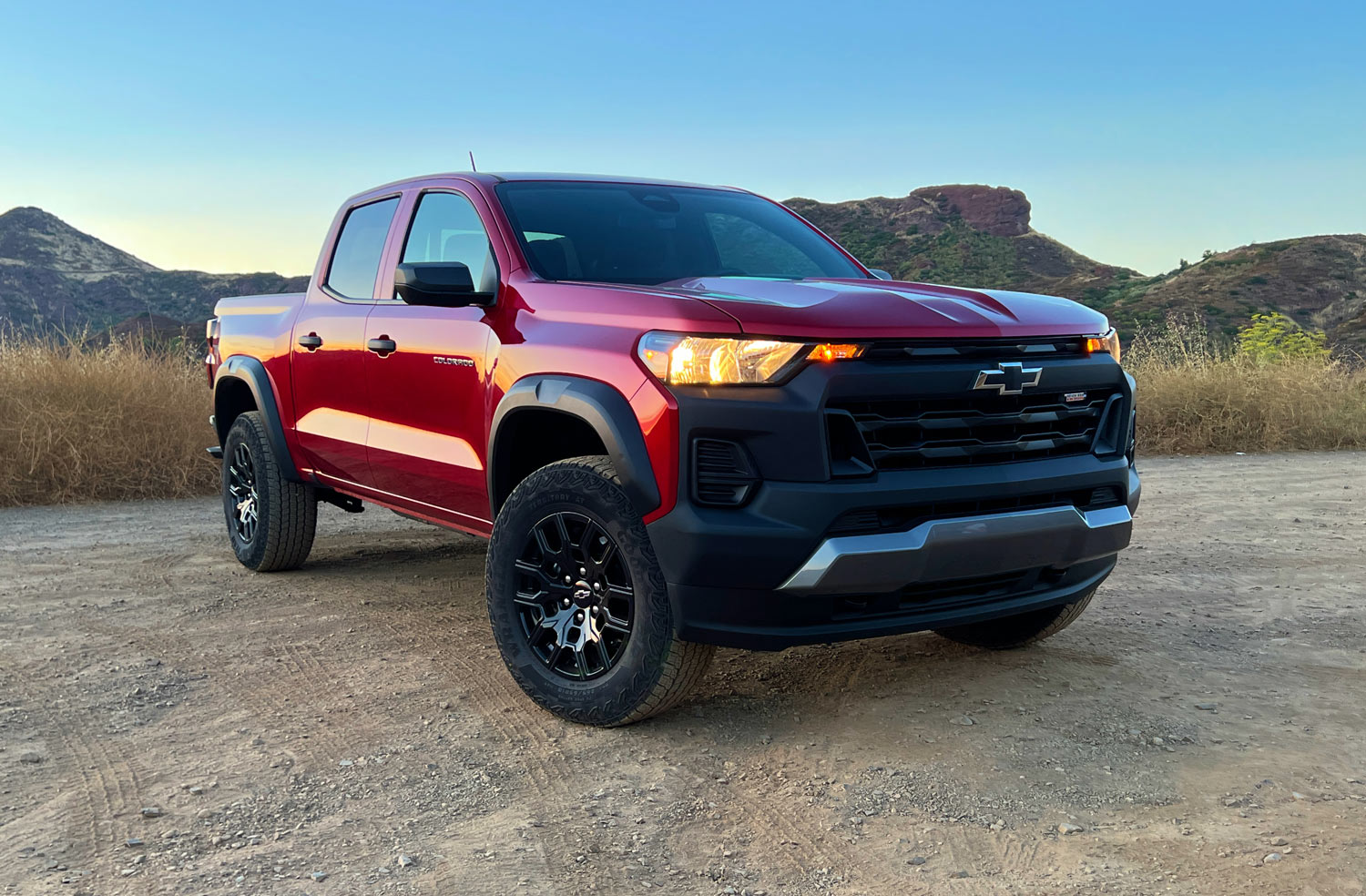 Christian Wardlaw
Christian Wardlaw
Nearly a decade ago, it seemed like small and midsize pickups were on life support. In 2014 only three models were available: the Honda Ridgeline, Nissan Frontier, and Toyota Tacoma. Of that trio, only the Taco appealed broadly to those who buy these kinds of trucks. That year, Toyota sold twice as many Tacomas as Nissan did Frontiers, and the quirky Ridgeline trailed them both by a significant margin.
The following year, the Honda went on hiatus, and General Motors returned to the segment with a vengeance. The second-generation Chevrolet Colorado and GMC Canyon models were stylistically appealing, technologically advanced for the time, and easily competitive with the Frontier and Tacoma. In fact, the second-generation Colorado and Canyon remained available through 2022. And despite its age and the segment's expansion to include seven trucks, the Colorado was still the second-best-selling model in the class.
Though the Colorado was successful, time stands still for no truck. So, GM redesigned the 2023 Chevrolet Colorado and its GMC Canyon fraternal twin. They come only in a crew-cab style equipped with a short bed that can hold 41.9 cubic feet of cargo loaded below the side rails. Most variants have standard four-wheel drive (4WD) and a suspension lift, reflecting personal-use trends emphasizing off-roading. Depending on the Colorado's configuration, the maximum towing capacity measures 7,700 pounds, and the maximum payload is 1,720 pounds.
 Christian Wardlaw
Christian Wardlaw
In addition to trimming the lineup to a single cab and bed specification, the 2023 Colorado features standard turbocharged power. Every trim level gets digital instrumentation, a Google-based widescreen infotainment system, and essential safety features. Chevy has also engineered this truck to deliver robust off-roading capability and impressive towing and hauling capacity. After living with one for a week, I found it feels as solid and secure as a bank vault.
The 2023 Chevrolet Colorado comes in Work Truck (WT), LT, Trail Boss, Z71, and ZR2 trim levels. A Desert Boss Special Edition version of the Colorado ZR2 is also available. Base prices range from the low $30,000s to the high $40,000s, including the destination charge to ship the truck from the Wentzville, Missouri, factory that builds it to your local dealership.
For this Colorado review, I test-drove the Trail Boss in Southern California. It came with extra-cost Radiant Red Tintcoat paint, upgraded mud-terrain tires, a spray-on bedliner, the Trail Boss Convenience Package II, the Skid Plate Package, and the Advanced Trailering Package. These upgrades brought the manufacturer's suggested retail price to $42,645, including the $1,495 destination charge. Chevrolet provided the vehicle for this Colorado Trail Boss review.
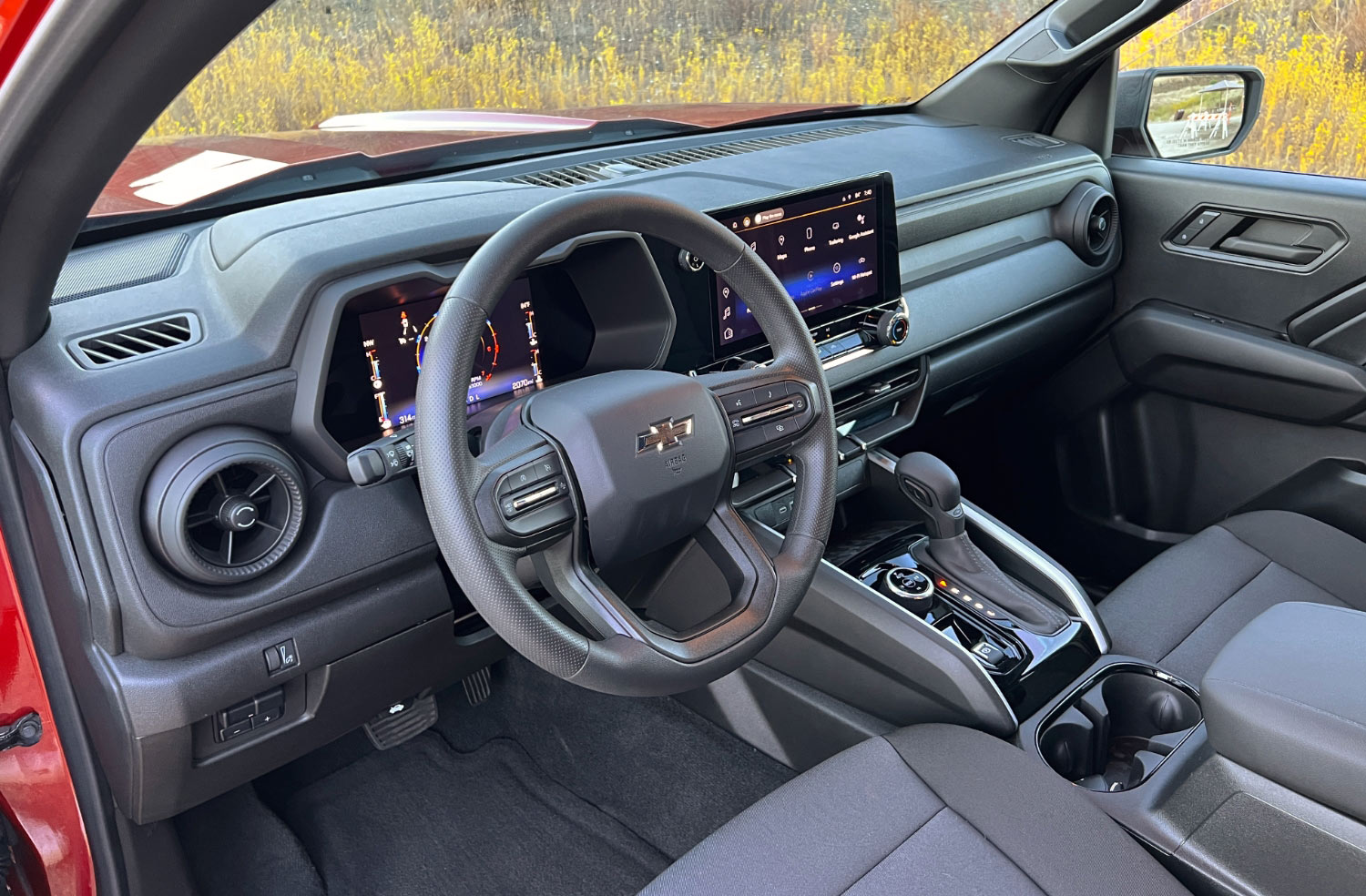 Christian Wardlaw
Christian Wardlaw
2023 Chevrolet Colorado: The Design
Styling is a subjective matter, but I think the new Colorado looks great. It boasts a tough and technical appearance with a longer wheelbase, shorter overhangs, taller ride height, and chiseled bodywork that swells and bulges in all the right places. Chevrolet also makes it easy to distinguish between the different trim levels through grille, bumper, and wheel designs, ensuring each version of the Colorado has some unique visual character.
Inside, the clean interior design and simple control layout recall the Camaro through round air vents anchoring each end of the dashboard and a few toggle switches controlling the automatic engine stop-start system, hazard flashers, and lane-keeping-assist system. Otherwise, an 8.0-inch digital instrumentation panel and an 11.3-inch touchscreen infotainment system dominate the Colorado's dashboard.
Remember the good old days when you could twist, push, or pull something to turn the headlights on or off quickly? Say goodbye to them. In the new Colorado, automatic operation is the default. If you want to adjust them manually, you need to remember which menu and submenu within the infotainment system provides the ability to do so.
I'm not a fan of the Colorado's windshield wipers, either. Chevrolet groups them with the turn signals on the left control stalk, and I prefer a separate right stalk for wiper operation.
With the Trail Boss trim, the Colorado's interior surface plastic is depressingly inexpensive in look and feel. The stuff is everywhere, so the seats and the front center armrest are the only soft spots. Compared to a Colorado Trail Boss, a Jeep Gladiator's interior materials seem decadent. Fortunately, the Colorado Z71 and ZR2 are nicer inside.
 Christian Wardlaw
Christian Wardlaw
Depending on the trim level, the Colorado's seat upholstery is cloth, EvoTex artificial leather, a mix of cloth and EvoTex, or perforated leather of dubious quality. I like cloth seats, which my test truck had, along with the eight-way power-adjustable driver's seat. The comfort is good, but I thought the front seats were too narrow, leading to fatigue on longer drives.
Chevrolet equips the Trail Boss with a manual single-zone climate-control system with refreshingly simple controls. The testing week saw Southern California in the grip of a heat wave, and the Colorado's robust air-conditioning system quickly cooled the cab. The Colorado also offers heated and ventilated front seats and a heated steering wheel, depending on the trim level and equipment.
All versions of the Colorado except the Work Truck also come with standard rear air-conditioning vents to ensure your passengers are just as comfortable. The Colorado's back seat is supportive, but legroom remains snug, just as in the previous-generation model. Fortunately, the front seatbacks are softly padded and kind to your knees and shins.
Storage space is adequate. The door-panel bins are unexpectedly small and shaped to hold only the narrowest of bottles. While the center-console storage bin under the armrest is deep, it is also narrow, making it harder to rummage around to find things by feel.
There is a useful tray in front of the transmission shifter, the glove compartment is generous, and the front and rear cupholders have smartphone slots between them. However, considering the gunk that accumulates at the bottom of cupholders, I can't imagine anyone wanting to use them for smartphone storage after the truck accumulates some mileage.
You can flip the rear seat cushion up to reveal underseat storage. Unfortunately, the seatback doesn't fold down to provide a flat and secure load area within the cab.
 Christian Wardlaw
Christian Wardlaw
The Colorado's cargo bed measures just over 5 feet long, and it includes eight cargo tie-down hooks and a tailgate offering a middle load position for hauling longer items without leaving it down. According to Chevrolet, the tailgate supports up to 500 pounds when set in the middle position. As with the previous Colorado, the new one has CornerStep bumpers that make it easier to climb into the bed or access items when necessary.
Upgrades include added cargo tie-downs, a spray-in bedliner, LED cargo-bed lighting, and a 110-volt power outlet. An EZ-Lift and Lower tailgate is available, along with remote tailgate locking. The test truck had the new-for-2023 StowFlex tailgate, which includes a storage compartment 45 inches wide and 4 inches deep, complete with a drain plug so you can use it to chill beverages.
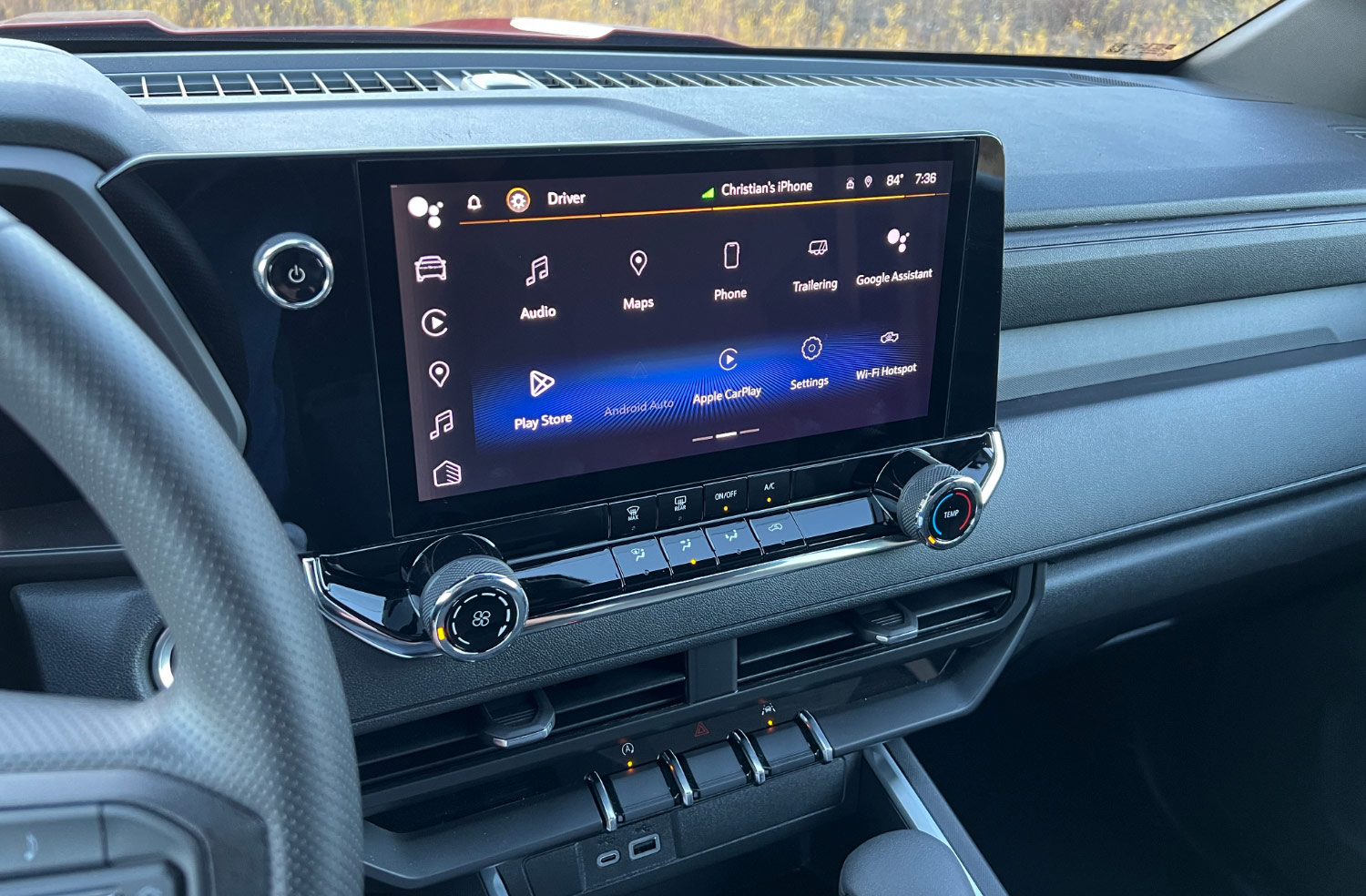 Christian Wardlaw
Christian Wardlaw
2023 Chevrolet Colorado: The Technology
With the 2023 Colorado, Chevrolet definitively drives the truck into the modern age, equipping it with a standard digital instrumentation display and a touchscreen infotainment system with Google technology. The standard instrumentation panel measures 8.0 inches — with an 11.0-inch screen in the ZR2 — and it provides access to plenty of data.
The showcase, however, is the 11.3-inch touchscreen infotainment display, which is standard in every Colorado, including the base Work Truck trim level. Google gives Colorado owners access to Google Maps navigation, the Google Play store, Google News, and a Google Assistant voice-recognition system.
 Christian Wardlaw
Christian Wardlaw
In addition, every Colorado comes with wireless Apple CarPlay and wireless Android Auto connectivity, SiriusXM satellite radio with a complimentary three-month trial subscription to service, and access to OnStar and Chevrolet Connected Services. This feature allows you to sign up for Wi-Fi service, activate the SOS emergency call service, and more. Wireless smartphone charging and a seven-speaker Bose premium sound system are available but not with all trim levels.
Chevrolet puts useful stereo volume and tuning controls on the back of the steering-wheel spokes, an excellent alternative to knobs or buttons on the dashboard — unless you're the front passenger. Nevertheless, you'll find a stereo power and volume knob to the upper left of the infotainment screen. My Trail Boss test truck also had Off-Road Performance Display pages showing a compass, altimeter, 3D pitch and roll measurements, a g-force meter, steering angle, and current tire pressures.
That sounds sophisticated, and in reality it is. However, I don't like this Google-based system as much as the previous Chevrolet Infotainment System 3. My dissatisfaction mainly relates to unexpected responses to my voice commands and, in general, an unusual user experience.
Regarding responsiveness, graphics, and general layout, this Google-based technology impresses. But interacting with the Google Assistant artificial intelligence forces me to reconsider my typical testing commands and prompts to obtain the desired results, typically by adding more specificity. In turn, this requires more consideration and thought process on the part of the driver, which is distracting. Still, I think owners will acclimate over time.
Chevrolet also offers plenty of trailering technology on the Colorado. This includes an integrated trailer-brake control system, trailering apps accessible via smartphone or infotainment system, and special camera-based assistance systems such as Hitch View and Hitch Guidance.
A high-definition reversing camera is standard, and you can get a surround-view camera on most Colorados. Chevy also offers underbody cameras that check the terrain to the front and rear of the truck. Unfortunately, they're unavailable with the Trail Boss trim.
Chevy Safety Assist is standard in all Colorado models. This package of advanced driving assistance systems (ADAS) installs forward-collision warning with an LED reflective windshield collision alert system, pedestrian and cyclist detection, automatic emergency braking, lane-departure warning, lane-keeping assist, and automatic high-beam headlights.
In addition, the 2023 Colorado has a standard safe-following-distance indicator, a rear-seat reminder system, a Buckle to Drive setting that prevents driving the truck if it detects unbuckled seatbelts, and Teen Driver technology. That feature allows Colorado owners to obtain a report card showing how a younger family member drove the truck while it was away from home.
Available ADAS upgrades include adaptive cruise control, an active blind-spot monitoring system, rear cross-traffic alert with automatic braking, rear parking sensors, and a rear pedestrian alert system. My test truck had none of these features.
It did, however, have a gap-adjustment button on the steering wheel. Initially, I thought it was for adaptive cruise control, but it didn't take long to figure out the Trail Boss didn't have that feature as it raced up to slower vehicles ahead. Instead, the gap adjustment governs the following distance and forward-collision warning systems.
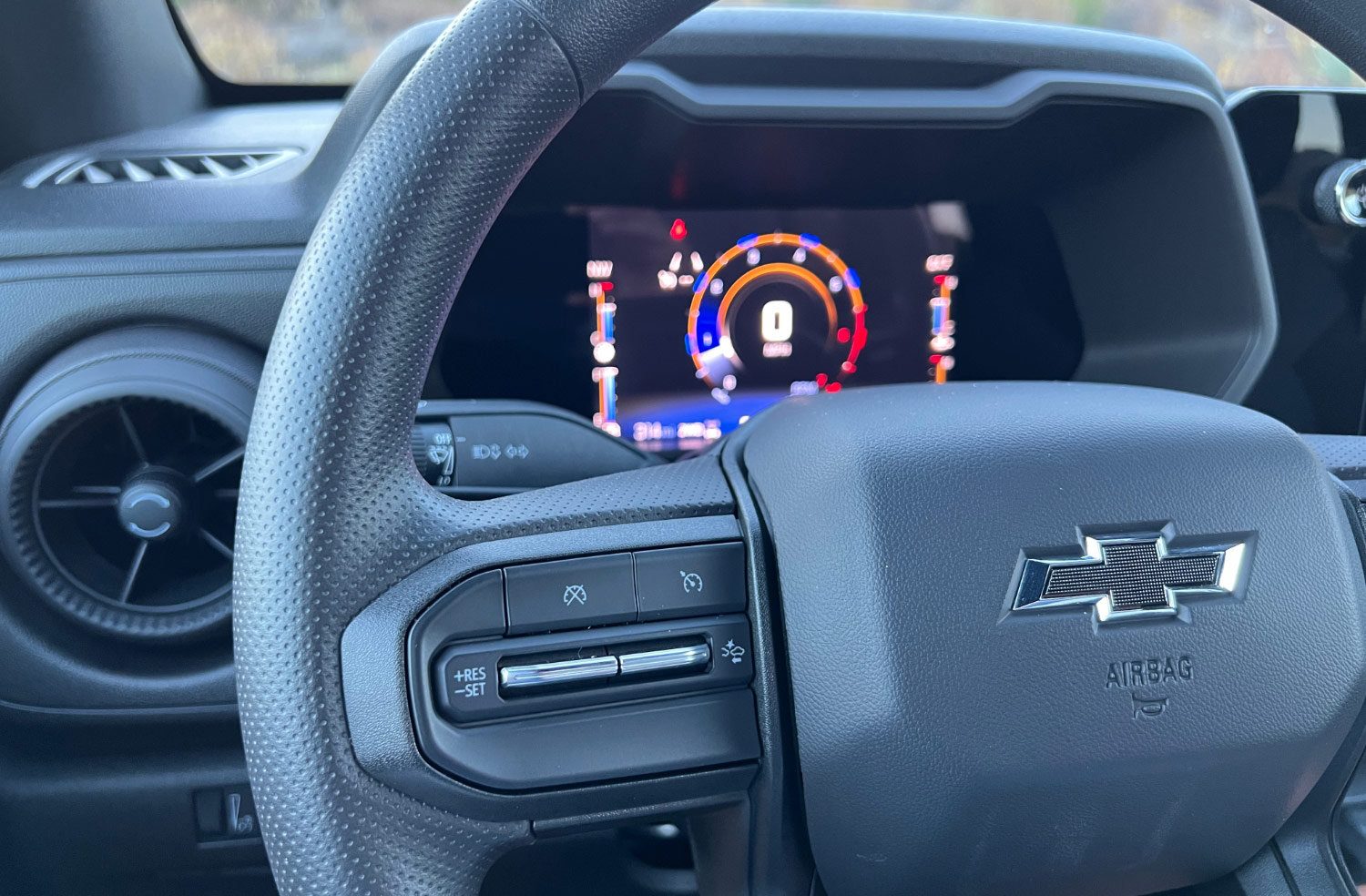 Christian Wardlaw
Christian Wardlaw
Chevrolet delivered the test truck with the most sensitive gap setting in effect. During the first few days of driving the truck, false forward-collision warning alerts were maddening. In one instance, I was driving along a winding, sun-dappled suburban boulevard lined with trees. There wasn't another car in sight. The forward-collision warning system twice issued a flashing red light and urgent beeping tone.
After I adjusted the gap setting to its lowest level of sensitivity, the Colorado's warning system calmed down some. But it still had trouble when passing through sharp transitions from sunlight to shadows, such as when entering the tunnels on Kanan Road in the Santa Monica Mountains.
It also perceived guardrails in curves as threats. It sometimes activated unnecessarily when another motorist cut into the gap ahead of the truck, issuing an alert after I'd released the accelerator pedal to slow down and increase the following distance.
One solution to this problem is to turn the forward-collision warning system off. I don't advise this course of action, but you won't get any more false alerts that way. The other solution is not getting a Colorado.
If you want to own this Chevrolet, my recommendation is to immediately reduce the gap-adjustment sensitivity level to its lowest setting and put up with the occasional flashing red light and beeping from the system. Eventually, you'll stop paying attention to it, which is the opposite of the technology's intended effect.
I experienced the same problem in a 2023 GMC Canyon, the Colorado's sibling.
Neither the National Highway Traffic Safety Administration (NHTSA) nor the Insurance Institute for Highway Safety (IIHS) has performed crash tests yet on the new Colorado. Check the
 Christian Wardlaw
Christian Wardlaw
2023 Chevrolet Colorado: The Drive
Every 2023 Chevy Colorado has a turbocharged 2.7-liter four-cylinder engine and an eight-speed automatic transmission. However, horsepower and torque ratings depend on the trim level.
In the WT and LT equipped with two-wheel drive, the engine whips up 237 horsepower at 5,600 rpm and 260 pound-feet of torque between 1,200 and 4,000 rpm. It can tow up to 3,500 pounds.
You can upgrade these models to the Turbo Plus version of the engine, which supplies 310 horsepower at 5,600 rpm and 391 lb-ft of torque at 2,000 rpm while boosting the towing capacity to 7,700 pounds. The Trail Boss and Z71 include the Turbo Plus engine as standard equipment. Starting with Trail Boss trim, the Colorado offers Normal, Tow/Haul, Off-Road, and Terrain driving modes.
The Colorado ZR2 gets a Turbo High Output version with 310 horsepower at 5,600 rpm and 430 lb-ft of torque at 3,000 rpm. In addition, the ZR2 has exclusive off-roading upgrades for the wheels, tires, and suspension. A Baja driving mode is exclusively available on the ZR2.
Choose the Colorado WT or LT, and you can opt for an automatic four-wheel-drive system (Autotrac) with a single-speed transfer case. It provides added traction in bad weather and offers light off-roading capability. Trail Boss, Z71, and ZR2 versions of the Colorado have an Autotrac two-speed transfer case for better crawl speed for off-roading. It operates in 2WD, Auto 4WD, 4-Hi, and 4-Lo, and is ready to handle just about any weather or terrain you encounter.
The Trail Boss and Z71 get a factory 2-inch suspension lift with a 3-inch wider track, giving the Colorado 9.5 inches of ground clearance. With the Colorado ZR2, the truck boasts a 3-inch suspension lift and 10.7 inches of ground clearance.
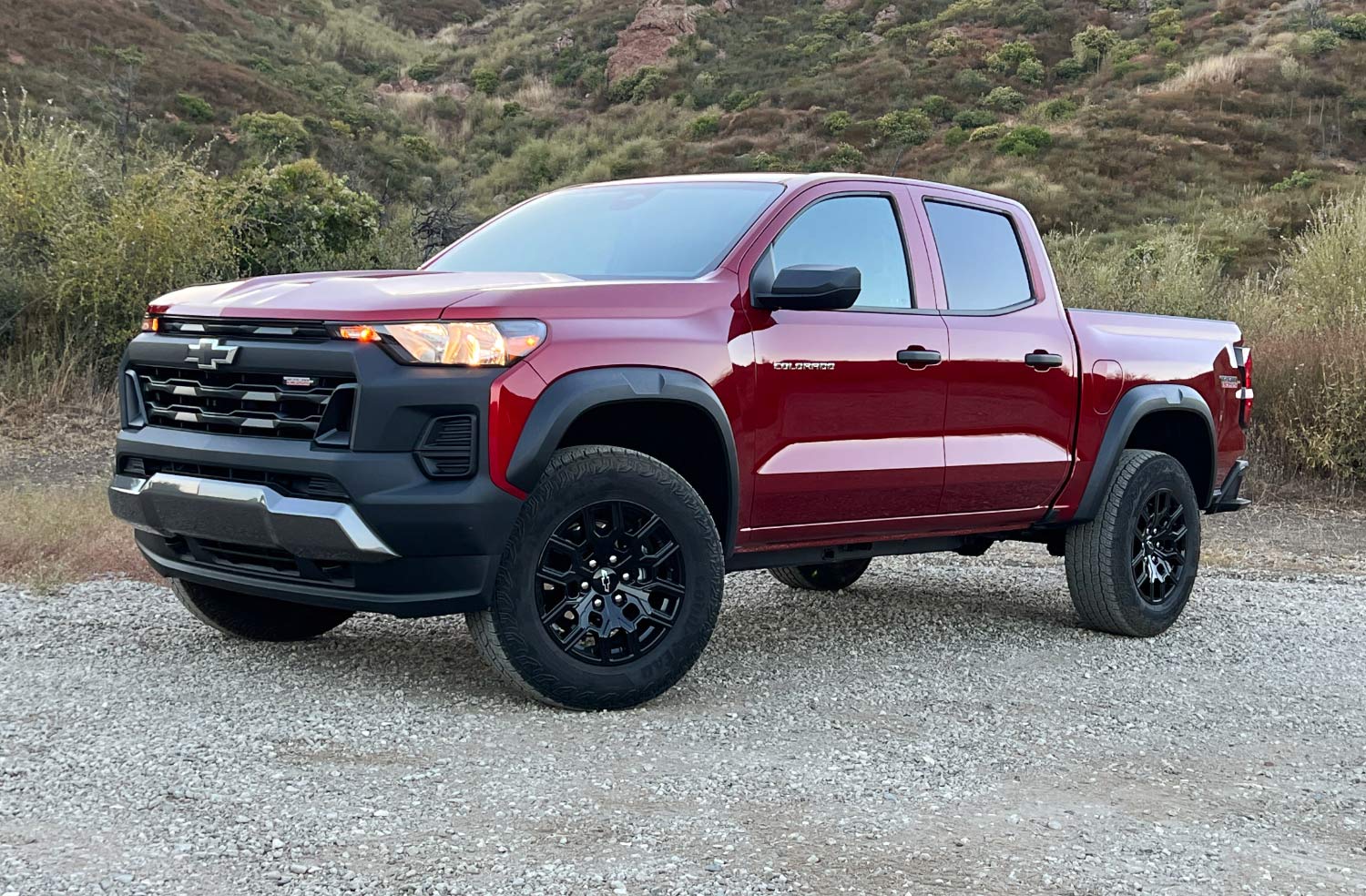 Christian Wardlaw
Christian Wardlaw
My Trail Boss test truck had gloss-black 18-inch wheels, Goodyear Wrangler Territory 32-inch mud-terrain tires, hill-descent control, and an automatic locking rear differential. A tire air-down mode is available through the infotainment system, and the Colorado's Easy Tire Fill Alert system refills the tires after your adventures. Additionally, my test truck had the Skid Plate Package but not the optional steel driveshaft.
Considering its power ratings, the Turbo Plus version of the 2.7-liter four-cylinder engine should feel more responsive to the driver. I expected a thrilling surge of torque accompanied by an enjoyable engine note but experienced neither. Nevertheless, acceleration is quick. However, on a few occasions, such as when accelerating out of a corner or around a cyclist on a mountain road, there was a slight delay between my request and the engine's response.
The Colorado has a standard automatic engine stop-start system, and it smoothly restarts the truck when the traffic light turns green or traffic ahead starts to move. It exists to improve fuel economy, and according to the EPA, a Colorado with optional mud-terrain tires should get 18 mpg. I averaged 17 mpg, including a short off-roading trip.
Equipped with an off-road suspension, the Colorado Trail Boss confidently takes on crumbling infrastructure. There is no need to slow for speed bumps or humps or to worry about heaves and holes in the pavement, and your days of curbing wheels and crunching air dams on parking blocks are over. The Trail Boss glided smoothly over cracked and patched Ventura County farm roads.
More impressively, the Colorado feels hewn from granite. From the driver's seat, you'll hear nary a thud, rattle, or creak, except from the driver's door panel when you brace your left knee against it. And even with its mud-terrain tires, blunt face, and lifted suspension, the Colorado's cabin proved remarkably quiet at highway speeds.
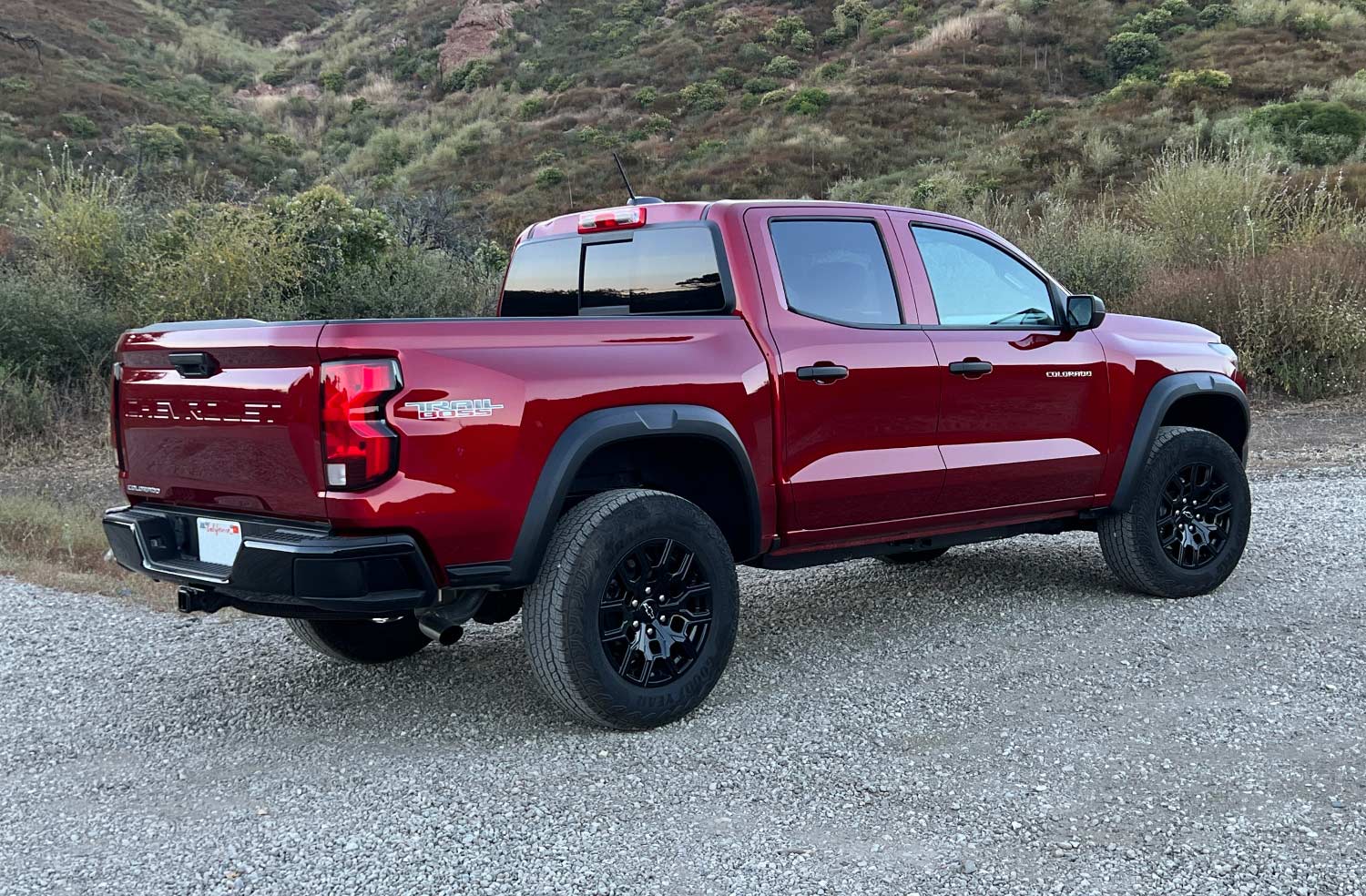 Christian Wardlaw
Christian Wardlaw
Surprisingly, the Colorado Trail Boss doesn't fall apart on a mountain road. Tire grip is limited. If you try to hustle this truck, it feels greasy in curves. Nevertheless, the steering weight and accuracy are commendable, the brake pedal feels good under your foot, and it demonstrates a flat cornering attitude. Also, thanks to excellent outward visibility, the Colorado is easy to drive on narrow winding roads and city streets as well as in parking lots.
I took the Colorado Trail Boss to a place with deep ruts, steep gullies, and dirt formed into moguls by winter rains and other off-roaders. At very low speeds, the Trail Boss felt bone-rattlingly firm but undeniably capable. Still, after whacking one of the skid plates despite the truck's 9.5 inches of ground clearance, I'd say Chevrolet should offer the underbody camera option for this version of the Colorado.
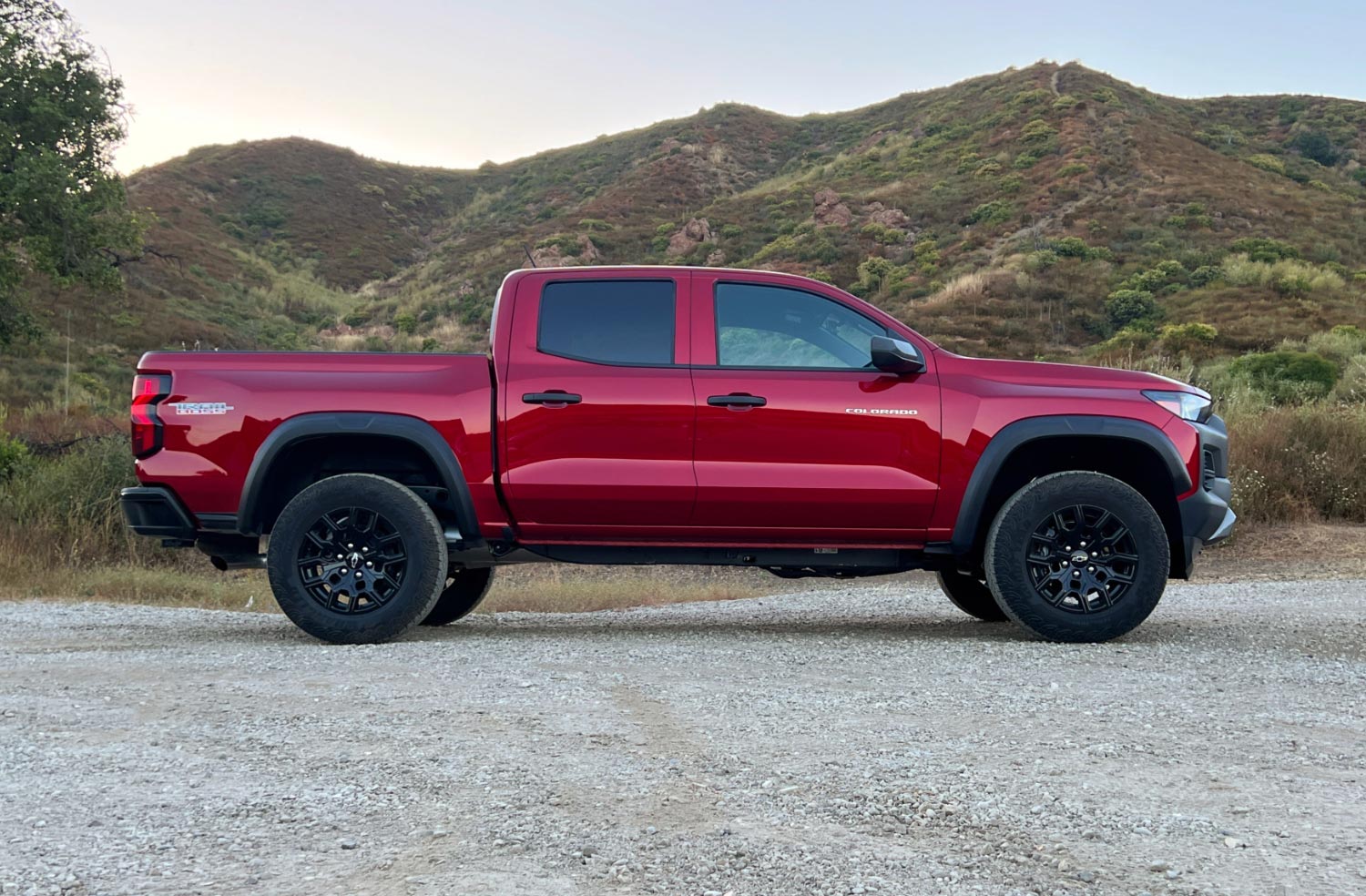 Christian Wardlaw
Christian Wardlaw
Is the 2023 Chevrolet Colorado a Good Truck?
Having spent a week mostly enjoying my time in the Colorado Trail Boss, I think it's a great truck. But there are three issues with it.
First, the Trail Boss's interior is too inexpensive looking. Even the LT trim level gets some silver plastic to break up the monotonous sea of shiny blackness. That is an easy fix, though it will increase Trail Boss's base price.
Also, getting 17 mpg from a midsize pickup with a four-cylinder engine is hard to accept. Granted, the tested Trail Boss with the Turbo Plus engine, 4WD, a lifted suspension, and mud-terrain tires is among the lowest-rated Colorados for fuel economy. But many people will likely get these features, negatively impacting their ownership costs.
The primary reason to skip the Colorado in favor of one of its rivals is the forward-collision warning system. Its inability to discern reality from fantasy is a daily source of irritation.
Written by humans.
Edited by humans.
 Christian Wardlaw
Christian WardlawMy first word was “car.” That’s what I’m told, anyway. For as long as I can remember, I’ve been obsessed with them. The design. The engineering. The performance. And the purpose. I’m a car enthusiast who loves to drive, but I’m also most interested in the cars, trucks, and SUVs that people actually buy. Anybody can tell you that a sports car is fast. What you need to know is whether or not you should buy that new SUV, and why. My life purpose is to help you make that decision.
Related articles
View more related articles